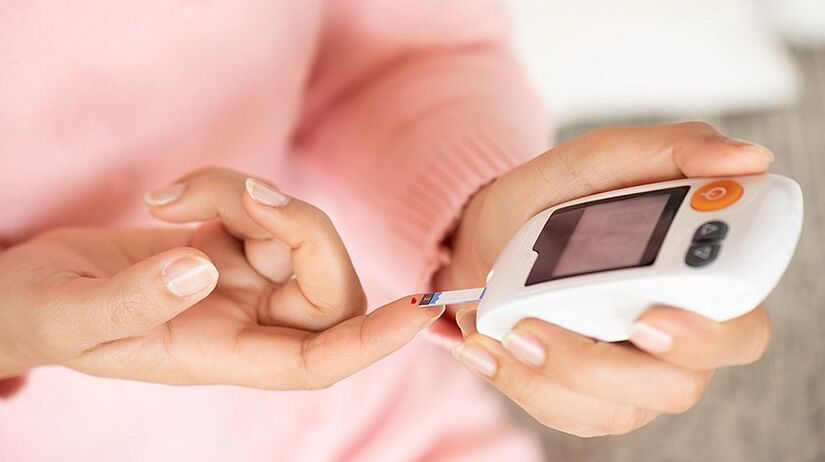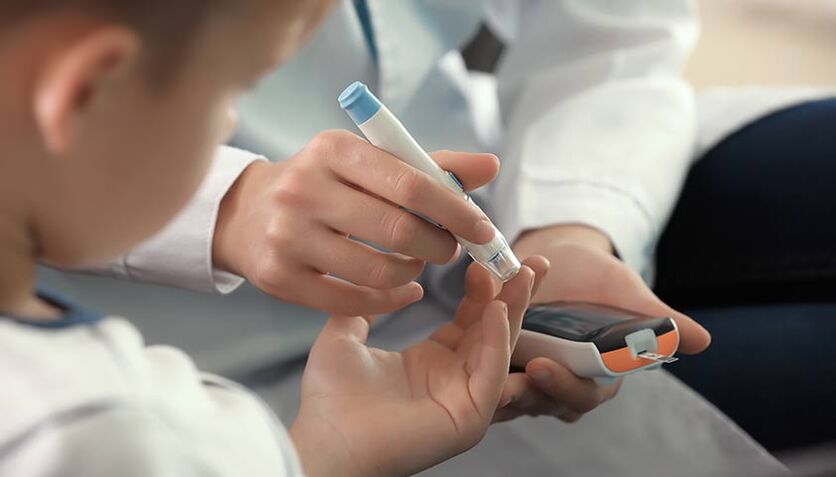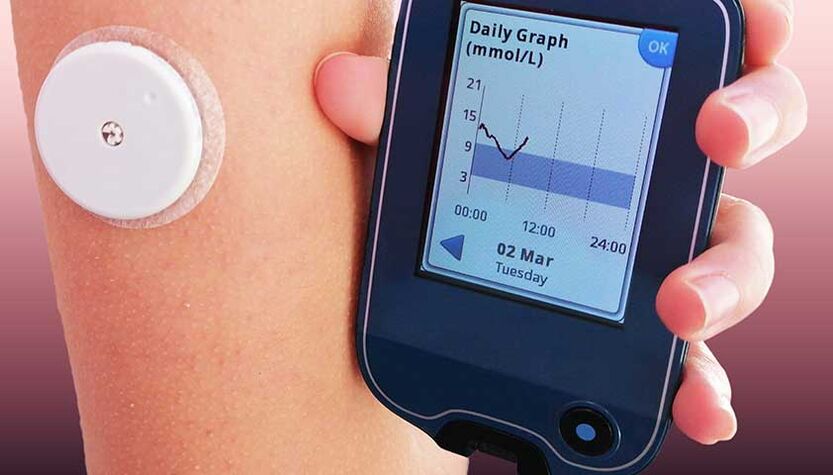
It is believed that diabetes develops in those who consume a lot of sweets. In fact, this is a much more complex pathology, which is only partly dependent on nutrition and can develop in any person.
Diabetes mellitus: definition of the disease
Diabetes mellitus (DM) is a group of diseases associated with metabolic disorders. People with diabetes cannot digest carbohydrates properly. As a result, their glucose (blood sugar) concentration increases significantly.
Glucose is a type of sugar that serves as the body's main source of energy.
Excess glucose has a toxic effect and destroys the walls of blood vessels, nerve fibers and internal organs.
Diabetes mellitus develops for various reasons. Some types of the disease are genetic in origin, while others are related to lifestyle or environmental factors.
The name of the disease was given by the ancient Greeks. Translated from Greek, διαβαίνω means "to pass through, " which refers to the main symptom of diabetes mellitus, polyuria, or frequent urination. Because of this, a person continuously loses fluid and strives to replenish it by drinking as much water as possible.
However, this is not always the case. Some forms of diabetes can develop asymptomatically for a long time or manifest themselves so mildly that a person does not even notice that something has gone wrong. And even with the typical course of the disease, many years often pass before excess glucose in the blood leads to the development of symptoms of the disease. Moreover, all this time the person is in a state of hyperglycemia, and at the time of diagnosis he already has severe irreversible disorders of the kidneys, blood vessels, brain, peripheral nerves, and retina.
The disease causes significant damage to the body. Without treatment, excess glucose can lead to deterioration in the function of the kidneys, heart, and nerve cells. But such complications can be prevented. Modern doctors have enough effective drugs and techniques for treating diabetes.
Prevalence
In 2019, diabetes was the direct cause of 1. 5 million deaths worldwide. Moreover, in almost half of the cases the disease was fatal in people under the age of 70 years. The other half of the patients died from complications of the disease: kidney failure, heart and vascular damage.

In addition to humans, animals also suffer from diabetes. For example, dogs and cats.
From 2000 to 2019, the mortality rate from diabetes in developed countries increased by 3%, and in lower-middle-income countries by 13%. At the same time, the likelihood of death from complications of the disease in people aged 30 to 70 years decreased by 22% worldwide. This is believed to be due to improved diagnosis of diabetes and effective methods for early prevention of its complications.
Classification of diabetes
In our country, we use the classification of diabetes mellitus approved by the World Health Organization in 1999.
Diabetes mellitus type I
With this type of disease, a person’s pancreas produces little of the hormone insulin, which is necessary for transporting glucose into cells. As a result, glucose entering the blood cannot be completely absorbed by the cells, remains in the vessels, is transported to the tissues and gradually destroys them.
Depending on the cause of pancreatic dysfunction, type I diabetes is divided into two subtypes: immune-mediated and idiopathic.
Immune-mediated diabetes mellitusthe result of autoimmune destruction of pancreatic cells, due to which the immune system mistakenly attacks its own healthy tissue. Diabetes typically begins in childhood or adolescence, but can develop in people of all ages.
Immune-mediated diabetes is often associated with other autoimmune disorders, such as Graves' disease, Hashimoto's thyroiditis, Addison's disease, vitiligo, or pernicious anemia.

Type 1 diabetes mellitus most often develops in children and adolescents, although it can occur at any age.
Idiopathic diabetes mellitus.A rare variant of the disease. Such patients do not have laboratory signs of autoimmune damage, but symptoms of absolute insulin deficiency are observed.
Diabetes mellitus type II
In this case, the pancreas produces enough insulin, but the cells are insensitive, or resistant, to it, so they cannot absorb glucose and it accumulates in the blood.
Depending on the leading cause, type II diabetes mellitus is divided into type II diabetes mellitus with predominant insulin resistance and relative insulin deficiency and type II diabetes mellitus with predominant impaired insulin secretion with or without insulin resistance.
Other specific types of diabetes
Other specific forms of the disease include pathologies with a pronounced genetic component, associated with infectious diseases or taking certain medications, and others.
Genetic defects in pancreatic β-cell functionthose types of diseases in the development of which a defective gene is clearly established.
Genetic defects in insulin actionthe development of pathology is associated with the peripheral action of insulin, which is disrupted due to mutations in the insulin receptor gene.
Diseases of the exocrine pancreas.For example, chronic pancreatitis and other inflammatory pathologies.
Endocrinopathiespathologies associated with excessive secretion of other hormones, such as acromegaly, Cushing's disease, hyperthyroidism.
Drug- or chemical-induced diabetes, can occur while taking hormonally active substances, α- and β-adrenergic agonists, psychoactive, diuretic, and chemotherapeutic drugs.
Diabetes associated with infectious diseases.As a rule, the disease develops due to viral infections (pathogens: Coxsackie, rubella, Epstein Barr viruses).
Unusual forms of immunologically mediated diabetes.For example, immobility and rigidity syndrome, systemic lupus erythematosus.
Other genetic syndromes, sometimes combined with diabetes.
Gestational diabetes mellitus
It first appears during pregnancy and is characterized by a decrease in the sensitivity of cells to glucose. It is believed that the disease develops due to an imbalance of hormones. After childbirth, the condition returns to normal or may develop into type II diabetes.
Causes of diabetes
Diabetes mellitus develops for various reasons, including genetic and autoimmune disorders, chronic pancreatic diseases, and dietary habits.
Common causes of diabetes:
- a malfunction of the immune system, due to which it attacks pancreatic cells;
- genetic disorders that impair tissue sensitivity to glucose, change the functioning of the pancreas and reduce or completely stop the synthesis of insulin necessary for the absorption of glucose;
- viral infections Coxsackie viruses, rubella, Epstein Barr, retroviruses can penetrate the cells of the pancreas and destroy the organ;
- chronic diseases that affect the pancreas, cystic fibrosis, pancreatitis, hemochromatosis;
- endocrine diseases Cushing's syndrome, acromegaly;
- toxins (for example, rodenticides, which are used to kill rodents, heavy metals, nitrates);
- dietary habits excess fats and simple carbohydrates in the diet can lead to obesity and decreased sensitivity of cells to insulin;
- medications, some hormonal drugs (in particular, glucocorticosteroids), certain medications for the treatment of diseases of the heart and nervous system, preparations of B vitamins (if consumed in excess).
Risk factors for diabetes
Depending on the type of diabetes, the risk factors for the disease differ.
Risk factors for type I diabetes:
- heredity - the likelihood of getting sick is higher if blood relatives have diabetes;
- Some viral infections (eg, rubella, infectious mononucleosis) can trigger an autoimmune reaction in the body, causing the immune system to attack pancreatic cells.

Excess weight does not cause type I diabetes, but it does increase the risk of developing type II diabetes.
The most common risk factors for type II diabetes mellitus, which are not directly related to an increase in blood glucose levels: excess weight, sedentary lifestyle, pregnancy, etc.
During physical activity, glucose is actively broken down to produce energy; substances supplied with food, as well as the body’s own fat reserves, are used as a substrate. With obesity, the volume and, accordingly, the area of the membranes of fat and other cells containing lipid inclusions increases, the relative density of insulin receptors per unit area decreases, as a result, the cells become less sensitive to insulin and absorb glucose worse.
Risk factors for type II diabetes mellitus:
- overweight and obesity;
- a sedentary lifestyle (without physical activity, glucose is broken down more slowly, so cells may become less sensitive to insulin);
- diabetes mellitus in blood relatives;
- age over 45 years;
- prediabetes is a condition in which the level of glucose in the blood remains at the upper limit of normal for a long time. Prediabetes is said to be present if the analysis shows values from 5. 6 to 6. 9 mmol/l;
- diabetes mellitus during pregnancy (gestational diabetes);
- birth of a child weighing more than 4 kg;
- depression;
- cardiovascular diseases;
- arterial hypertension (pressure above 140/90 mm Hg);
- high levels of "bad" high-density cholesterol (more than 0. 9 mmol/l) and triglycerides (more than 2. 82 mmol/l);
- polycystic ovary syndrome.
Symptoms of diabetes
Type I diabetes mellitus usually manifests itself as pronounced symptoms; other types of the disease can develop unnoticed for a long time.
Common symptoms of diabetes:
- strong thirst;
- weakness;
- frequent urination;
- bedwetting in children who have not wet the bed before;
- sudden weight loss for no apparent reason;
- constant strong feeling of hunger;
- frequent urinary tract infections or fungal infections.
Separately, there are so-called secondary symptoms of diabetes mellitus, which appear in the later stages of the disease and signal complications.
Secondary symptoms of diabetes:
- itchy skin;
- nausea;
- vomit;
- abdominal pain;
- dry mouth;
- muscle weakness;
- blurred vision;
- poorly healing wounds;
- numbness in fingers or toes;
- acanthosis nigricans darkening of the skin on the neck, armpits, elbows and knees;
- diabetic dermopathy pigment spots with atrophy and peeling of the skin, located on the bends of the lower extremities, often appear due to poor healing of wounds of the legs;
- diabetic pemphigus blisters on the lower extremities ranging in size from a few millimeters to several centimeters. Most often occur in elderly patients with long-term diabetes;
- headache;
- smell of acetone from the mouth.

Acanthosis nigricans, or darkening of the skin on the neck, knees, elbows, and armpits, may be a sign of diabetes.
Complications of diabetes
Complications typically develop in patients with advanced diabetes mellitus and include retinopathy, nephropathy, and polyneuropathy.
Destruction of large vessels leads to atherosclerosis, myocardial infarction, stroke, and encephalopathy.
Constant monitoring of blood glucose and taking medications to lower its level can prevent or delay irreversible complications of diabetes.
In addition, the regeneration of small vessels is disrupted. Because of this, wounds on the body do not heal well. So, even a small cut can turn into a deep festering ulcer.
Diabetic coma
Diabetic coma is a complication of diabetes associated with too high or, conversely, low blood sugar levels.
Depending on the concentration of glucose in the blood, diabetic coma is divided into two types: hypoglycemic (associated with a decrease in sugar levels) and hyperglycemic (caused by an increase in its level).
Hypoglycemic comausually occurs in people with diabetes who are on insulin therapy.
The cause of such a coma is excess insulin, which prevents the body from raising blood glucose levels to normal levels. This often happens when the dose of insulin is incorrectly calculated or the diet is disrupted, in which the amount of insulin administered does not correspond to the portion of carbohydrates from the food eaten.
Precursors of hypoglycemic coma:
- trembling in the body,
- chills,
- dizziness,
- nervousness or anxiety
- severe hunger
- nausea,
- blurry vision,
- heart rhythm disturbance.
"Rule 15" to stop hypoglycemia in diabetes:
If your "sugar" level is reduced, you should eat 15 g of fast carbohydrates (drink juice, take a glucose tablet) and measure your blood glucose after 15 minutes. If its level is low, eat another 15 g of fast carbohydrates. Repeat these steps until the sugar rises to at least 3. 9 mmol/l.
In rare cases, low blood sugar may cause a person to pass out. In such a situation, he needs an urgent injection of the hormone glucagon, which is performed by an ambulance worker.
Some people mistakenly believe that a person in a hypoglycemic coma needs to have a sweet liquid poured into their mouth. However, this is not the case and is fraught with asphyxia (suffocation).
Hyperglycemic comaaccompanied by an acute lack of insulin, which can be caused by severe stress or an insufficient dose of insulin after meals.

Dangerous hyperglycemia is said to occur if the blood glucose level exceeds 13. 9 mmol/L.
Symptoms of hyperglycemia:
- strong thirst
- frequent urination,
- extreme fatigue
- blurry vision,
- smell of acetone or fruity breath,
- nausea and vomiting,
- abdominal pain,
- rapid breathing.
If such symptoms appear, you should sit down as soon as possible, ask others to call an ambulance, or call an ambulance yourself.
Diagnosis of diabetes mellitus
If a person has symptoms of increased blood sugar concentrations: constant thirst, frequent urination, general weakness, blurred vision, numbness in the limbs, you should consult a general practitioner as soon as possible.
But most often, diabetes mellitus develops asymptomatically, so it is recommended that all people undergo a screening test once a year to detect the disease in the early stages and prevent the development of complications.
Which doctor should I contact if I suspect diabetes mellitus?
As a rule, people first turn to a general practitioner. If diabetes is suspected, he refers them to a specialized specialist who treats metabolic pathologies, an endocrinologist.
During the consultation, the doctor will conduct a survey and examination, and to confirm the diagnosis and determine the severity of diabetes, he will prescribe laboratory and instrumental tests.
Inspection
If diabetes is suspected, the doctor will clarify the medical history: cases of the disease in blood relatives, chronic pathologies of the pancreas, lifestyle, recent infectious diseases.
There are no specific signs of diabetes that can be detected during examination.
During the examination, the doctor will also assess the condition of the skin: with diabetes mellitus, dark areas of acanthosis nigricans may appear on it. In addition, a specialist can perform a rapid glucose test. Exceeding normal values is a reason for an in-depth examination.
Laboratory research methods
For diagnosis, a blood glucose test is prescribed. Its high level along with characteristic symptoms such as constant thirst, frequent urination, frequent infectious diseases is a clear sign of diabetes.
Blood glucose concentration is measured using one of the following tests: fasting and postprandial plasma glucose testing, glycated hemoglobin (HbA1c) level, which reflects the average blood sugar level over the past 3 months.
An HbA1c level of no more than 6. 0% (42 mmol/l), a glucose level of no more than 5. 5 mmol/l is considered normal.
To make an accurate diagnosis, the study is performed at least twice on different days. If the results are ambiguous, a glucose tolerance test is performed, which allows identifying impaired cell sensitivity to glucose.
In addition, your doctor may order additional tests to distinguish type 1 diabetes from type 2 diabetes: an autoantibody test and a urine ketone body test.
Antibodies are usually present in people with type I diabetes, and ketone bodies with type II diabetes.
To assess the sensitivity of cells to insulin, the doctor may order a test to calculate the HOMA-IR (Homeostasis model assessment of insulin resistance) index, which takes into account the level of glucose and insulin in the blood.
If hereditary forms of diabetes are suspected, experts may recommend genetic testing to identify mutations associated with hereditary forms of diabetes mellitus and glucose intolerance.
Instrumental research methods
Instrumental examinations help identify complications of diabetes: damage to the retina, damage to the heart, blood vessels, kidneys, and nerve conduction disorders.
An ultrasound examination of internal organs is prescribed to assess the condition of the kidneys and pancreas. In addition, the doctor may refer the patient for an ECG to detect abnormalities in the heart.
To diagnose visual disorders, you will need to consult an ophthalmologist. During an ophthalmological examination, the doctor evaluates the condition of the retina and examines the cornea through a slit lamp or using an ophthalmoscope.
Treatment of diabetes
There is no cure for diabetes. Therapy is aimed at maintaining acceptable blood glucose levels and preventing complications of the disease.
People diagnosed with diabetes need to regularly measure their blood glucose levels, inject insulin for type 1 diabetes or take tablets for type 2 diabetes, or inject insulin to control blood sugar levels.
To prevent complications of the disease, your doctor may recommend other medications. For example, medications to control blood pressure, thin the blood and prevent cardiovascular disease, as well as drugs that lower blood cholesterol.
Monitoring blood glucose levels
To monitor blood glucose levels, classic glucometers and modern continuous monitoring systems are used.
A glucometer is a device equipped with a thin needle. A person pricks his finger with it and drips blood onto a special test strip. The glucometer immediately shows the result.
Monitoring systems are sensors that are installed on the shoulder, stomach or leg. These sensors constantly monitor blood glucose levels. Data from the device is automatically downloaded to a special monitor or to an application on the phone. Such devices can signal spikes in blood sugar, plot glucose curves over periods of time, send information to your doctor, and even make recommendations on emergency and routine measures and the need to change diabetes treatment tactics.

Wearing the monitoring system does not hurt; it is not felt on the body.
Diet for diabetes
There is no special diet for people with diabetes, but it is important for people with this diagnosis to count the amount of carbohydrates they eat every day and keep a food diary.
Carbohydrate counting
Carbohydrates affect blood sugar levels the most, so it is important for people with diabetes not to eliminate them, but to count them.
Carbohydrate counting is the basis of the diet for people with diabetes who are on insulin therapy. To do this, use the universal parameter bread unit (XE).
1 XE corresponds to approximately 15 g of net carbohydrates or 20–25 g of bread and increases blood glucose levels by an average of 2. 77 mmol/l. To absorb such an amount of glucose, a dose of insulin of 1. 4 units is required.
The amount of carbohydrates in the diet of a person with type I diabetes on average should not exceed 17 bread units per day.
The amount of carbohydrates that a person with diabetes can normally tolerate varies from person to person and depends on weight, level of physical activity, daily calorie needs and how the body metabolizes carbohydrates.
You can calculate the required amount of carbohydrates per day with a nutritionist or your doctor. After converting the carbohydrates you eat into bread units, your doctor will help you determine the amount of insulin that will be needed to absorb glucose. Over time, a person will learn to calculate this himself.
In addition, there are other dietary recommendations for people with diabetes:
- limit the calorie intake of all overweight patients;
- minimize the content of fats (primarily animal origin) and sugars in food;
- consume carbohydrates mainly from vegetables, whole grains and dairy products;
- exclude or limit the consumption of alcoholic beverages (no more than 1 conventional unit for women and 2 conventional units for men per day).
Forecast and prevention of diabetes mellitus
Diabetes mellitus is a chronic disease that cannot be completely cured. But medications and healthier lifestyle changes help avoid complications and slow the progression of the disease.
Without treatment, the prognosis for diabetes mellitus is unfavorable: a person may die due to damage to the cardiovascular system.
Ways to prevent diabetes:
- regular physical activity;
- varied diet with sufficient fiber, protein, fat and carbohydrates;
- healthy weight control;
- reducing alcohol consumption;
- giving up alcohol and smoking.
Nutrition for the prevention of type II diabetes mellitus
An important part of preventing type II diabetes is a healthy and varied diet. The principle, or method, of a healthy plate has been developed for this purpose.
The Healthy Plate Method divides foods into five main groups: fruits and vegetables, slow-release carbohydrates, dairy, proteins and fats. You can combine these groups using a regular plate. Fruits and vegetables should make up a third or half of it. Slow carbohydrates a third or a little more. The remaining part is occupied by dairy products, a little more protein foods, and a small part by fats.

Eating according to the principle of a healthy plate: half is fiber, ⅓ slow carbohydrates, the rest protein foods.
In addition, other important principles of healthy eating should be observed:
- drink according to thirst;
- eat less salt, no more than a teaspoon (5–6 g) per day;
- limit the consumption of trans fats (found in many prepared and processed fast food products, cakes and pastries);
- reduce the consumption of saturated fats (found in sweet pastries, fatty meats, sausages, butter and lard);
- eat less sugar, no more than 7 teaspoons (30 g) per day.
























